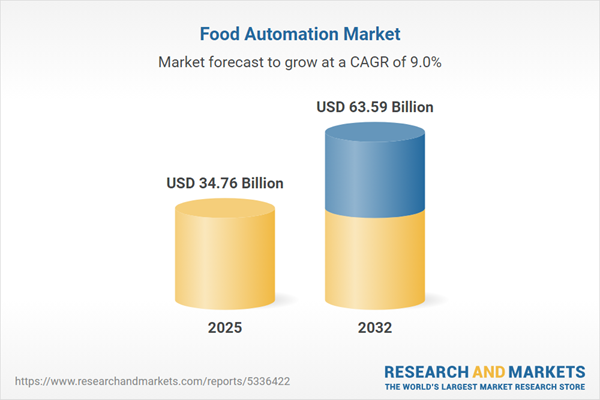Speak directly to the analyst to clarify any post sales queries you may have.
The food automation market is advancing rapidly as food sector stakeholders implement automated technologies to improve production efficiency, quality, and safety. Intelligent systems are reshaping traditional processing environments, empowering decision-makers to navigate emerging business challenges and growth opportunities.
Market Snapshot: Global Food Automation Market Outlook
The Food Automation Market grew from USD 31.88 billion in 2024 to USD 34.76 billion in 2025. It is projected to expand at a CAGR of 9.01%, reaching USD 63.59 billion by 2032. This robust expansion reflects widespread adoption of intelligent automation technologies across core industry segments, driven by rising demand for operational agility and traceable value chains. Investments in robotics, vision systems, edge computing, and data-driven software are transforming how both large enterprises and smaller facilities compete on quality, safety, and responsiveness.
Scope & Segmentation
- Component: Hardware (including conveyors such as belt, chain, and roller types; robotic arms, covering articulated, delta, and SCARA robots; sensors; and vision systems); Software (AI engines, analytics platforms, and control systems)
- Application: Packaging, processing (cooking, cutting, mixing), quality inspection, sorting
- End User: Bakeries, dairy facilities, food processing plants, quick-service restaurants
- Regions: Americas (United States, Canada, Mexico, Brazil, Argentina, Chile, Colombia, Peru), Europe, Middle East & Africa (UK, Germany, France, Russia, Italy, Spain, Netherlands, Sweden, Poland, Switzerland, UAE, Saudi Arabia, Qatar, Turkey, Israel, South Africa, Nigeria, Egypt, Kenya), Asia-Pacific (China, India, Japan, Australia, South Korea, Indonesia, Thailand, Malaysia, Singapore, Taiwan)
- Key Companies: ABB Ltd., AMETEK Inc., DESTACO, Emerson Electric Co., Falcon Autotech, Fanuc, Festo, Fortive, GEA Group, JLS Automation, Kuka AG, MAYEKAWA, Mitsubishi Electric, Neologic Engineers, Regal Rexnord, Rockwell Automation, Schneider Electric, Omron Electronics, John Bean Technologies, Heat and Control, SPX FLOW, Food Automation Pty Ltd., YASKAWA Electric, NORD Drivesystems
Key Takeaways for Senior Decision-Makers
- Automation investments are shifting from large enterprises to include small and medium-sized facilities, supported by modular, rapidly deployable solutions.
- Recent advances in collaborative robotics, machine vision, and edge computing are enabling integrated autonomous workflows and supporting agile production models.
- Consumer trends such as demand for clean labeling, traceability, and individualized nutrition are compelling producers to embed more data analytics and compliance controls.
- Operational agility is critical as production cells become reconfigurable and manufacturers must respond swiftly to market or regulatory change.
- Global and regional players are driving innovation through acquisitions, partnerships, and the integration of AI capabilities for predictive quality control and reduced operational risks.
- Segment-specific needs—for example, in bakeries versus high-throughput dairy plants—are influencing the evolution of modular architectures and flexible service models.
Tariff Impact and Supply Chain Strategies
In 2025, targeted US trade tariffs on imported robotics components and vision systems are prompting OEMs to rethink sourcing strategies and adapt to new material cost structures. Many industry participants are mitigating risk by increasing domestic component partnerships, leveraging free trade zones, and investing in hybrid automation systems that combine imported and local technology. Enhanced supply chain visibility—supported by blockchain solutions and close logistics provider relationships—is becoming vital for managing ongoing tariff fluctuations and ensuring uninterrupted automation rollouts.
Research Methodology & Data Sources
This report is built from in-depth primary and secondary research. It synthesizes insights from senior executive interviews, published industry studies, regulatory filings, and proprietary supplier data. Findings undergo triangulation and validation to ensure robust, actionable intelligence for all stakeholders in the food automation ecosystem.
Why This Report Matters
- Enables informed investment decisions by clarifying technology adoption patterns, operational innovations, and regional market opportunities within the food automation space.
- Provides segment-specific and regional insights that help stakeholders fine-tune their go-to-market strategy and adapt to evolving compliance or trade measures.
- Supports long-term planning with a clear view of emerging collaborative models, supply chain shifts, and strategic alliances shaping the industry’s future.
Conclusion
The dynamic expansion of food automation is redefining manufacturing, quality assurance, and supply chain resilience. Those who align with modular, data-driven trends and anticipate regulatory change will strengthen their market position. This report delivers the clarity needed for strategic growth.
Additional Product Information:
- Purchase of this report includes 1 year online access with quarterly updates.
- This report can be updated on request. Please contact our Customer Experience team using the Ask a Question widget on our website.
Table of Contents
3. Executive Summary
4. Market Overview
7. Cumulative Impact of Artificial Intelligence 2025
Companies Mentioned
The companies profiled in this Food Automation market report include:- ABB Ltd.
- AMETEK Inc.
- DESTACO, A Dover Company
- Emerson Electric Co.
- Falcon Autotech Pvt Ltd.
- Fanuc Corporation
- Festo Inc.
- Fortive Corporation
- GEA Group Aktiengesellschaft
- JLS Automation
- Kuka AG
- MAYEKAWA MFG. CO., LTD.
- Mitsubishi Electric Corporation
- Neologic Engineers Private Limited
- Regal Rexnord Corporation
- Rockwell Automation, Inc.
- Schneider Electric
- Omron Electronics, LLC
- John Bean Technologies
- Heat and Control, Inc.
- SPX FLOW, Inc.
- Food Automation Pty. Ltd.
- YASKAWA Electric Corporation
- NORD Drivesystems Private Limited
Table Information
| Report Attribute | Details |
|---|---|
| No. of Pages | 199 |
| Published | November 2025 |
| Forecast Period | 2025 - 2032 |
| Estimated Market Value ( USD | $ 34.76 Billion |
| Forecasted Market Value ( USD | $ 63.59 Billion |
| Compound Annual Growth Rate | 9.0% |
| Regions Covered | Global |
| No. of Companies Mentioned | 25 |









